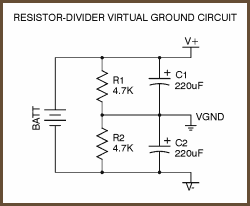I have iBasso DX90, that have 1,7V line out. It is absolutly sufficient for my 32ohm headphones. DX90 signal path is ES9018K2M -> OPA1602 (I/V) -> OPA1611 (LPF) -> Line Out (over capacitors). I have idea about using diamond buffer, without anything else, as maximal purest portable headphone amplifier:
- No need voltage amplification
- No need potenciometr (DX90 have precise digital volume control)
- No need input/output capacitors (I hope)
How much is lowest supply voltage for diamond buffer, if maximum signal will be 1,7V?
Can I use for this simple battery symmetrical supply as is on this image?

- No need voltage amplification
- No need potenciometr (DX90 have precise digital volume control)
- No need input/output capacitors (I hope)
How much is lowest supply voltage for diamond buffer, if maximum signal will be 1,7V?
Can I use for this simple battery symmetrical supply as is on this image?

There are a few things wrong with your idea.
First, buffers perform much better when driven by an op amp in a nested circuit. For direct coupled applications, the improved DC performance (which will provide lower DC output offset with less drift) is a must have. AC performance is improved in this configuration, too.
Second, your virtual ground will not work very well for a buffer stage. A buffered virtual ground is required for lowest distortion. This means that you will in essence have a three channel amplifier. Best to buffer a device like the TLE2426 for the output ground. The signal ground goes directly to the output of the TLE2426.
This added complexity makes a strong case for capacitor coupled, single ended amplifier for portable applications. The output capacitors will take up a lot of space though; 500 uF is a minimum recommended value for hi fidelity applications.
While your DAC is probably capacitor coupled at the output, many portable devices already employ a three channel amplifier with buffered virtual ground output. Just look at the datasheets for low voltage "rail to rail" stereo headphone amps for portable applications and you'll see what I mean. If you build a two channel amplifier with passive virtual ground for use with these products, you will get some interesting and disappointing results.
Here's an article discussing 3 channel applications and virtual grounds. NwAvGuy: Virtual Grounds & 3 Channel Amps
When you take all this into consideration, it makes a two battery power supply with a "real" ground seem like a good choice. This will work with any source, whether it has a"real" ground or a virtual ground. Always use capacitors on the input.
So those are some issues for you to think about before you decide on a configuration.
First, buffers perform much better when driven by an op amp in a nested circuit. For direct coupled applications, the improved DC performance (which will provide lower DC output offset with less drift) is a must have. AC performance is improved in this configuration, too.
Second, your virtual ground will not work very well for a buffer stage. A buffered virtual ground is required for lowest distortion. This means that you will in essence have a three channel amplifier. Best to buffer a device like the TLE2426 for the output ground. The signal ground goes directly to the output of the TLE2426.
This added complexity makes a strong case for capacitor coupled, single ended amplifier for portable applications. The output capacitors will take up a lot of space though; 500 uF is a minimum recommended value for hi fidelity applications.
While your DAC is probably capacitor coupled at the output, many portable devices already employ a three channel amplifier with buffered virtual ground output. Just look at the datasheets for low voltage "rail to rail" stereo headphone amps for portable applications and you'll see what I mean. If you build a two channel amplifier with passive virtual ground for use with these products, you will get some interesting and disappointing results.
Here's an article discussing 3 channel applications and virtual grounds. NwAvGuy: Virtual Grounds & 3 Channel Amps
When you take all this into consideration, it makes a two battery power supply with a "real" ground seem like a good choice. This will work with any source, whether it has a"real" ground or a virtual ground. Always use capacitors on the input.
So those are some issues for you to think about before you decide on a configuration.
Circuit depending I think you are looking at around -/+8 volts as a minimum. You probably could use a virtual ground arrangement but I suspect a diamond buffer suitably biased to drive low impedance headphones might be just a bit to power hungry for simple 9 volt battery packs.
Here's a newer generation "rail to rail" op amp that can drive low impedance headphones directly and can work off voltages from 4.5 to 36 volts. http://www.digikey.com/product-search/en?keywords= opa1612 Three of these, a TLE2426. and a handful of passive parts and you can build a compact, high quality, three channel virtual ground amplifier that will work with any audio source.
Mooly's right about a diamond buffer using too much quiescent current for use with a battery power supply.
Mooly's right about a diamond buffer using too much quiescent current for use with a battery power supply.
I have some 35ohm headphones (AT MSR7s) and they go way too loud even when fed 0.5VRMS so I figure what you need is a step down trafo 4:1. You can wind one on a PQ20/20 core, needs a couple of hundred turns on the secondary and about 800 on the primary.
- Status
- Not open for further replies.
- Home
- Amplifiers
- Headphone Systems
- Diamond buffer as portable amplifier